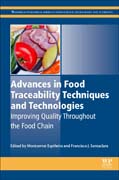
Advances in Food Traceability Techniques and Technologies: Improving Quality Throughout the Food Chain
Espiñeira, Montserrat
Santaclara, Francisco J
Advances in Food Traceability Techniques and Technologies: Improving Quality Throughout the Food Chain covers in detail a topic of great importance to both the food industry which is obliged to provide clear and accurate labeling of their products and the government and other organizations which are tasked with verification of claims of food quality and safety. The traceability of food products is becoming ever more important as globalization continues to increase the complexity of food chains. Coverage in the book includes the wide range of technologies and techniques which have been utilized in the tracing of food products. In addition, the ways in which the misuse of food traceability will affect the quality of food is also covered throughout. The first part of the book introduces the concept of traceability in the food industry, highlighting advantages of a robust traceability and the difficulties involved in implementing them. The second part looks at the technologies used to trace products, and the third section reviews the legal requirements for food traceability in the EU, the US, and the rest of the world. The final section contains a number of case studies which evaluate how food traceability has been successfully implemented in various foods focusing on the quality of the food. Provides a wide ranging overview of all recent advances in food traceability techniques and technologiesPresents case studies covering when food traceability techniques have been applied to a range of food stuffsCovers the legal aspects of food traceability in the EU, the USA, and around the world INDICE: Part 1: Introduction to food traceability 1. What is food traceability? 2. Defining and analysing food supply chains 3. Advantages of traceability in the food industry 4. Traceable resource units (TRU) in the food industry 5. Problems and implementation hurdles in food traceability Part 2: Development of methods, devices and sensors for food traceability 6. Alphanumerical coding for food traceability 7. Optical coding systems for food traceability 8. Radio-frequency identification usage in food traceability 9. Wireless sensor networks for food traceability 10. The use genetics in food traceability 11. The use of NIR in food traceability 12. The use of ICP-MS in food traceability 13. Future technologies in tracing of animals in the food chain 14. Traceability software for the food industry 15. Use of the internet for food traceability 16. Real-time tracking capabilities in food traceability Part 3: Legal requirements and regulation in food traceability 17. Legal requirements and regulation for food traceability in the EU 18. Legal requirements and regulation for food traceability in the US 19. Legal requirements of regulation for food traceability in the rest of the world Part 4: Case studies in food traceability 20. Effective use of food traceability in product recalls 21. Effective use of food traceability in evaluating origin claims 22. Effective use of food traceability in fruit and vegetable food supply chains 23. Effective use of food traceability in cereal grain food supply chains 24. Effective use of food traceability in meat supply chains 25. Effective use of food traceability in fish supply chains 26. Effective use of food traceability in dairy products 27. Effective use of food traceability in wine 28. Effective use of food traceability in animal feed
- ISBN: 978-0-08-100310-7
- Editorial: Woodhead Publishing
- Encuadernacion: Cartoné
- Páginas: 400
- Fecha Publicación: 23/06/2016
- Nº Volúmenes: 1
- Idioma: Inglés
